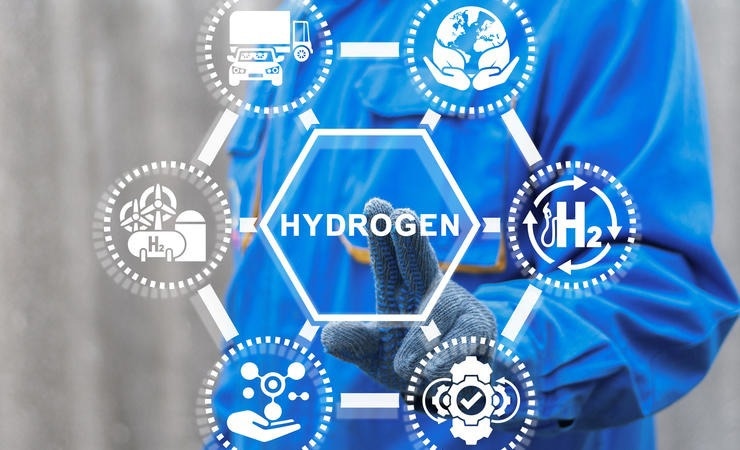Sharing a long history, the energy industry and hydrogen technology have experienced remarkable growth in recent times.
Hydrogen, the most abundant element in the universe, is proving its value as a positive contributor to the energy blend: generating power for communities, propelling various modes of transportation (automobiles, trains, trucks, and ships), and aiding the decarbonization of hard to abate industries, such as steel and glass manufacturing.
As per the findings of the IEA (International Energy Agency) in January 2023 (“Hydrogen Patents for a Clean Energy Future”), “in response to government action and raised expectations for the competitiveness of clean energy, more capital is flowing to key hydrogen technologies.”
Prominent companies are harnessing the potential of hydrogen to manifest a more environmentally friendly, efficient, and sustainable future.
- Linde plc: Headquartered in the U.K. and Dublin, Ireland, this global chemical company stands as one of the major players in the industrial gas sector, specializing in the distribution and production of gases like nitrogen, oxygen, acetylene, argon, and process gases, including hydrogen and helium.
In September 2022, the company unveiled plans to construct a 35- 35-megawatt PEM (Proton Exchange Membrane) electrolyzer for the production of green hydrogen in Niagara Falls, New York. This facility, the largest electrolyzer plant Linde has deployed globally, is expected to double its capacity for green liquid hydrogen production in the United States.
- Air Liquide International S.A.: Positioned as a leading hydrogen generation enterprise based in France, it offers commercial solutions in technology, gases, and healthcare services.
Air Liquide is collaborating with TotalEnergies to produce renewable and low-carbon hydrogen at the Grandpuits Zero Crude Platform, aligning with France’s commitment to expand its renewable energy sources.
- Messer Group GmbH: This Germany-based hydrogen production company specializes in industrial gases such as nitrogen, oxygen, carbon dioxide, argon, shielding gases, hydrogen, helium, and medical gases.
In 2021, it established a partnership with Siemens Energy to advance green H2 projects for mobility and industrial applications.
- Air Products and Chemicals, Inc.: With its headquarters in Pennsylvania, United States, the company specializes in industrial gases and chemicals. It has recently joined forces with the Government of Canada and the Province of Alberta to develop a net-zero hydrogen energy complex.
- Reliance Industries Ltd.: Based in Mumbai, India, Reliance Industries Limited operates in various sectors including natural gas, petrochemicals, energy, telecommunications, retail, and textiles.
In 2022, the company disclosed plans to allocate $76 billion for clean energy initiatives. The company has also recently unveiled a hydrogen-powered truck at India Energy Week.
- Cummins Inc.: Established in 1919, Cummins Inc. is a U.S. corporation renowned for manufacturing, designing, and distributing diesel engines and power generation products. A few years ago, the company successfully acquired Hydrogenics Corporation, a developer of fuel cell and hydrogen generation technology.

Image Credit: Omniseal Solutions

Image Credit: Omniseal Solutions
Going Beyond in Hydrogen: A Range of Color Possibilities
Many people are familiar with hydrogen in its traditional colors like green, blue, and even gray. However, there are other lesser-known variations like yellow, turquoise, black/brown, and pink hydrogen that form a diverse spectrum within the energy sector to categorize different hydrogen types. These include:
- Blue hydrogen primarily originates from natural gas via steam reforming, combining natural gas with heated water. Nevertheless, it generates carbon dioxide as a byproduct. The use of carbon capture and storage (CCS) is essential to trap and store this carbon.
- Green hydrogen is produced with minimal greenhouse gas emissions, utilizing clean electricity sourced from renewable energy sources like solar or wind power to electrolyze water. Electrolyzers split water into hydrogen and oxygen components, emitting zero carbon dioxide. Due to its higher cost, green hydrogen is not used as much as blue hydrogen, but there is hope of lowered pricing as it becomes more common.
- Grey hydrogen is the most prevalent hydrogen production method, generated from natural gas (methane) through steam methane reforming. However, it does not capture greenhouse gases.
- Black and brown hydrogen use black coal or lignite (brown coal). The opposite of green hydrogen, black and brown hydrogen are the most environmentally damaging.
- Pink hydrogen is produced via the process of electrolysis using nuclear energy (also referenced as purple hydrogen or red hydrogen).
- Turquoise hydrogen is a recent addition to the hydrogen spectrum, produced via methane pyrolysis. This type of hydrogen is still undergoing testing, but it holds the potential to be a low-emission variant depending on the thermal production and carbon storage processes.
- Yellow hydrogen is another recent type resulting from electrolysis powered by solar energy.
- White hydrogen is harnessed from naturally occurring geological hydrogen found in underground deposits and is produced during the fracking process. Currently, this remains a relatively unexplored area.
Exploring the Hydrogen Value Chain & the Value of Sealing Solutions
In the hydrogen value chain, typically, three domains come into play: 1) production, 2) storage and distribution, and 3) refueling stations. Each sector is specialized and demands expertise to manage safety, expenses, and adherence to regulations, codes, and standards (RCS).
Challenges of significant magnitude are present in these sectors, prompting companies in the carbon-free/renewable/hydrogen energy sectors to seek guidance and support from exceptionally knowledgeable engineers and scientists.
- As previously mentioned, hydrogen is generated through various methods, but those most in line with the net zero roadmap include green hydrogen utilizing renewable electricity sources and electrolysis and blue hydrogen originating from natural gas via steam reforming with CO2 capture and storage.
In hydrogen storage and transmission, hydrogen is transmitted or stored in liquid or gaseous form. Sealing solutions such as Omniseal® polymer and metallic parts from Omniseal Solutions provide reliability and tightness performance that match the requirements of these challenging applications.
An example of this durability is Omniseal’s spring-energized seals that are qualified in the world’s first Liquefied Hydrogen (LH2) loading arm in the receiving terminal at Kobe, Japan, airport island.
- Hydrogen Refueling Stations (HRS) encompass several pivotal components operating under elevated pressure and temperatures ranging from 20 °K to 300 °F, presenting technical challenges that stretch the boundaries of existing sealing solutions.
As a response, Omniseal Solutions has undertaken extensive testing to refine materials and sealing approaches, aiming to tackle the most formidable applications, even up to extreme pressure of 110 MPa in hydrogen gas or liquid.
- In hydrogen energy and material applications (fuel cells, battery systems, hydroelectric, etc.), qualified operating companies and component manufacturers are expected to understand requirements and conditions related to high-pressure, high temperature / cryogenic equipment; safe operations of hydrogen and conformity of parts, equipment, and plant.
Omniseal Solutions is engaged in collaboration with numerous key companies to devise and fabricate an all-encompassing selection of polymer and metal sealing components, along with advanced materials, to surmount diverse technical hurdles within the hydrogen value chain.
For instance, Omniseal Solutions’ Rulon® fluoropolymer gaskets cater to the necessities of PEM or alkaline electrolyzers, while its Omniseal® polymer and metal seals fulfill the demands of transporting/storing and distributing hydrogen gas or liquid under extreme pressures.
All of Omniseal Solutions’ precision components are tailor-made to deliver enhanced chemical resistance and dependability in contrast to conventional sealing solutions.

This information has been sourced, reviewed and adapted from materials provided by Omniseal Solutions.
For more information on this source, please visit Omniseal Solutions.